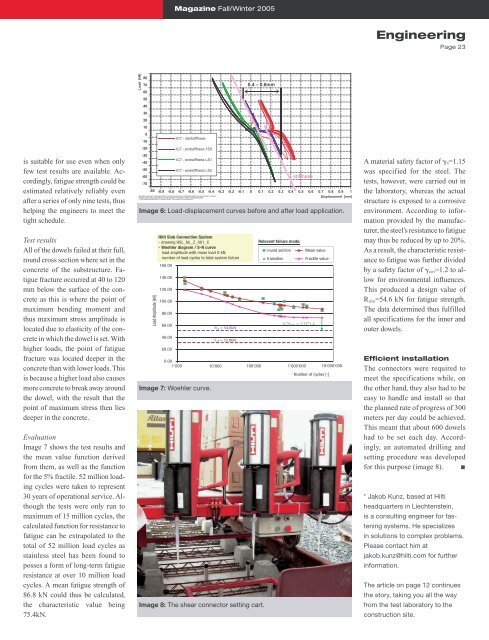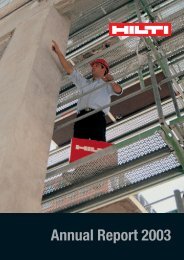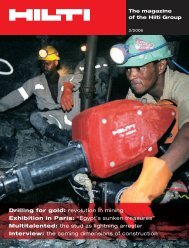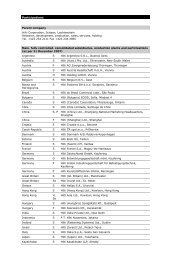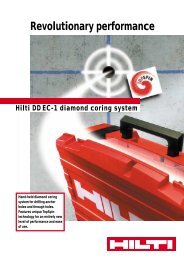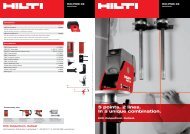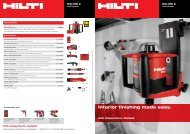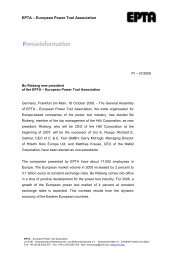Netherlands: high-tech fastening for high-speed track ... - Hilti
Netherlands: high-tech fastening for high-speed track ... - Hilti
Netherlands: high-tech fastening for high-speed track ... - Hilti
Create successful ePaper yourself
Turn your PDF publications into a flip-book with our unique Google optimized e-Paper software.
Magazine Fall/Winter 2005<br />
Engineering<br />
Page 23<br />
is suitable <strong>for</strong> use even when only<br />
few test results are available. Accordingly,<br />
fatigue strength could be<br />
estimated relatively reliably even<br />
after a series of only nine tests, thus<br />
helping the engineers to meet the<br />
tight schedule.<br />
Test results<br />
All of the dowels failed at their full,<br />
round cross section where set in the<br />
concrete of the substructure. Fatigue<br />
fracture occurred at 40 to 120<br />
mm below the surface of the concrete<br />
as this is where the point of<br />
maximum bending moment and<br />
thus maximum stress amplitude is<br />
located due to elasticity of the concrete<br />
in which the dowel is set. With<br />
<strong>high</strong>er loads, the point of fatigue<br />
fracture was located deeper in the<br />
concrete than with lower loads. This<br />
is because a <strong>high</strong>er load also causes<br />
more concrete to break away around<br />
the dowel, with the result that the<br />
point of maximum stress then lies<br />
deeper in the concrete.<br />
Evaluation<br />
Image 7 shows the test results and<br />
the mean value function derived<br />
from them, as well as the function<br />
<strong>for</strong> the 5% fractile. 52 million loading<br />
cycles were taken to represent<br />
30 years of operational service. Although<br />
the tests were only run to<br />
maximum of 15 million cycles, the<br />
calculated function <strong>for</strong> resistance to<br />
fatigue can be extrapolated to the<br />
total of 52 million load cycles as<br />
stainless steel has been found to<br />
posses a <strong>for</strong>m of long-term fatigue<br />
resistance at over 10 million load<br />
cycles. A mean fatigue strength of<br />
86.8 kN could thus be calculated,<br />
the characteristic value being<br />
75.4kN.<br />
Image 6: Load-displacement curves be<strong>for</strong>e and after load application.<br />
Image 7: Woehler curve.<br />
Image 8: The shear connector setting cart.<br />
A material safety factor of S=1.15<br />
was specified <strong>for</strong> the steel. The<br />
tests, however, were carried out in<br />
the laboratory, whereas the actual<br />
structure is exposed to a corrosive<br />
environment. According to in<strong>for</strong>mation<br />
provided by the manufacturer,<br />
the steel’s resistance to fatigue<br />
may thus be reduced by up to 20%.<br />
As a result, the characteristic resistance<br />
to fatigue was further divided<br />
by a safety factor of corr=1.2 to allow<br />
<strong>for</strong> environmental influences.<br />
This produced a design value of<br />
R d,fat=54.6 kN <strong>for</strong> fatigue strength.<br />
The data determined thus fulfilled<br />
all specifications <strong>for</strong> the inner and<br />
outer dowels.<br />
Efficient installation<br />
The connectors were required to<br />
meet the specifications while, on<br />
the other hand, they also had to be<br />
easy to handle and install so that<br />
the planned rate of progress of 300<br />
meters per day could be achieved.<br />
This meant that about 600 dowels<br />
had to be set each day. Accordingly,<br />
an automated drilling and<br />
setting procedure was developed<br />
<strong>for</strong> this purpose (image 8).<br />
* Jakob Kunz, based at <strong>Hilti</strong><br />
headquarters in Liechtenstein,<br />
is a consulting engineer <strong>for</strong> <strong>fastening</strong><br />
systems. He specializes<br />
in solutions to complex problems.<br />
Please contact him at<br />
jakob.kunz@hilti.com <strong>for</strong> further<br />
in<strong>for</strong>mation.<br />
The article on page 12 continues<br />
the story, taking you all the way<br />
from the test laboratory to the<br />
construction site.


